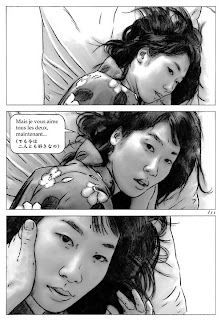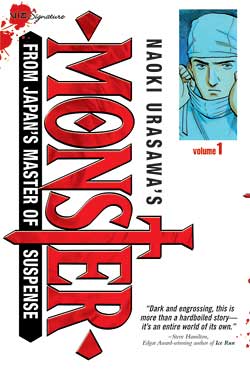We haven’t done this in a while.
 Jack Kirby‘s Fourth World Omnibus, Volume 1
Jack Kirby‘s Fourth World Omnibus, Volume 1
Everything went right with this book, which collects the early issues of Kirby’s “Fourth World” comics for DC (Jimmy Olsen, Forever People, New Gods, and Mister Miracle), with the stories printed in order of their original publication. Some have complained about the paper stock, which is superficially reminiscent of newsprint (I’ve heard this “choice” came down to a production mistake, though that may just be rumor), but it works very well, in my opinion. The coloring is as good as it gets for this kind of archival treatment. In terms of story, this is pretty close to the deep end for pure Kirby weirdness, and those who haven’t read much by him might be better off starting with his ’60s Marvel work. Or maybe not. The ’70s period finds Kirby’s art and bizarre ideas as close to “art comics” as he would ever get.
This has been one of the most widely reviewed comics collections of the year (deservedly so), so I won’t go on too much longer, but I do want to say that I really enjoy how Kirby throws in subplots and imagery with incredibly disturbing implications (the underground government cloning facility, the fact that the very first person they decided to clone was Superman (an incredibly incautious choice, I’d think)) in an almost offhand manner, barely commented upon by the characters. There are a lot more levels to these stories than might seem initially apparent.
 Richard Sala‘s Delphine #1-2
Richard Sala‘s Delphine #1-2
I’m also really enjoying this new series from Sala, which is part of Fantagraphics’s Ignatz line. I’m still kicking myself that I didn’t really get Sala’s work in time to follow The Chuckling Whatsit and Mad Night in their original serialized form, so it’s great to get another chance with this new series, which seems to be loosely based on the Snow White story. Sala’s done some great work with short pieces, but these Judex-like serials are where he really excels. One panel in the first issue actually made me jump (well, not really jump—I was sitting down—but the sedentary equivalent of jumping, anyway). Good stuff.
 Rick Geary‘s Treasury of Victorian Murder: The Borden Tragedy
Rick Geary‘s Treasury of Victorian Murder: The Borden Tragedy
For some reason, Rick Geary’s drawing style has never really appealed to me—it seems too twee or something, I guess—but enough people whose taste I trust have recommended him to me over the years that I finally decided to give him a try. I’m glad I did. This narrative reconstruction of the infamous Lizzie Borden trial and the murders that led up to it is masterfully done, and a pretty obvious riposte to my ignorant lament that not enough comics were taking advantage of the form’s natural strengths for exploring historical topics. Geary uses a tremendous amount of innovative layouts and formal techniques (pretty much everything I imagined earlier, as well as others I hadn’t anticipated) to great effect, and this is a compelling true crime tale. In the end, it may seem like not much more than a well-executed genre piece, but when considered with the other titles in this series (which I definitely plan on sampling), that judgment may prove too harsh. And there’s certainly a place for good genre work, anyway. I’m still not the biggest fan of Geary’s drawings, but they do what he wants them to, which is what counts. (I’m sometimes repelled by Steve Ditko‘s art, for that matter, and he’s one of my favorites.)
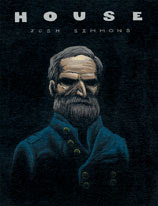 Josh Simmons‘s House
Josh Simmons‘s House
I’ve enjoyed a few of Josh Simmons’s mini-comics over the years, but this is a real step up, and a very promising book-length debut. This short, atmospheric horror story follows three young people exploring a strange, abandoned house, and the first half of the book is filled with surprising and even exhilarating moments. I don’t want to give the plot away, but after being so pleased by the beginning of the book, I was a little disappointed by the ending, which felt too protracted and schematic for my taste. The author pretty clearly intended that effect, though, so maybe I’ll be more receptive after a few re-readings. In any case, Simmons displays an original voice, and this is inexpensive and impressive enough for me to recommend it to anyone interested in horror or wordless comics. I am excited to see what Simmons comes up with next.
 Minetaro Mochizuki’s Dragon Head, Vols. 1-4
Minetaro Mochizuki’s Dragon Head, Vols. 1-4
What is wrong with me? Everyone else in the world, from Dan to seemingly every comics reviewer on the Internet, is raving about this manga, but four volumes in, I’m still indifferent. So far, the story follows two high-school students trapped in a train tunnel after some kind of apocalyptic incident, and their struggle to survive and escape. It’s all put together extremely well, but follows the J-horror/apocayptic fiction formulas so closely that I’ve never once felt surprised. I’ve been assured by others that the series gets better as it goes, but I’m about ready to give up. This feels a lot like any number of “good” television shows (Lost, Heroes) that I don’t feel like I have the time to follow, and I don’t think the fact that these characters are drawn is going to keep me going. I am probably wrong about this series.
Finally, in the so far, so good files:
 Osamu Tezuka‘s Apollo’s Song
Osamu Tezuka‘s Apollo’s Song
I haven’t finished this yet, but I’m loving it, and I’m really glad that Vertical is putting out these relatively obscure Tezuka titles. When the Phoenix volumes came out, I wasn’t really ready for them. The bizarre and wonderful storytelling in this, Ode to Kirohito, and Buddha has given me new eyes.
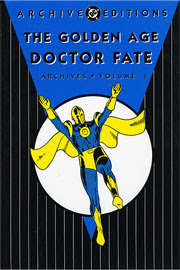 Gardner Fox and Howard Sherman‘s Golden Age Doctor Fate Archives
Gardner Fox and Howard Sherman‘s Golden Age Doctor Fate Archives
This book is too expensive if you can’t find a deal somewhere, but so far, this is nothing but great, brainless, golden-age fun. I can’t read too many of these stories at once, but it’s terrific in small portions.
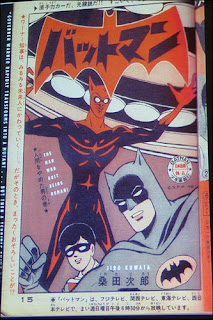 For those of you who don’t already know, Frank’s begun writing occasionally for Publishers Weekly. His latest piece is a review of the Chip Kidd-co-edited collection of Jiro Kuwata superhero comics, Bat-Manga! I wish I hadn’t read it myself, because now I have another stupid book I need to buy, but check it out if you have money to spare (or better impulse control).
For those of you who don’t already know, Frank’s begun writing occasionally for Publishers Weekly. His latest piece is a review of the Chip Kidd-co-edited collection of Jiro Kuwata superhero comics, Bat-Manga! I wish I hadn’t read it myself, because now I have another stupid book I need to buy, but check it out if you have money to spare (or better impulse control).












